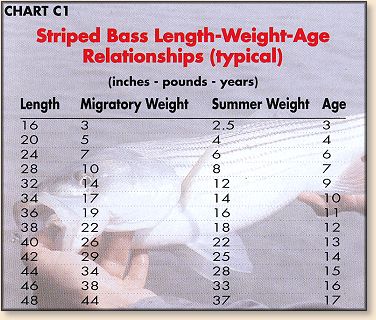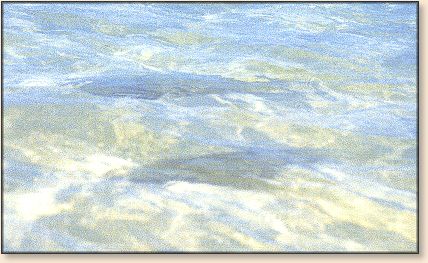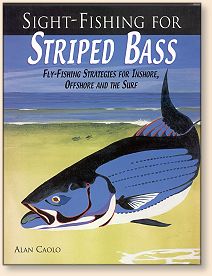Sight-fishing occurs in water temperatures of 60°F
to 72°F; the warm upper range for striper activity.
These temperatures occur in the summer when stripers
have ceased migrating and have become resident throughout
their northern range. The cool water temperatures
associated with spring and fall trigger migratory
behavior where striped bass become very active and
feed aggressively on the baitfish that are also in
transit. But during the summer the fish are mluch
less active, eat less, and are quite casual about
their feeding. The variety and abundance of forage
available to stripers during the summer further adds
to their selective nature, making them a challenging
sight-fishing quarry. Summer stripers feed sparsely
and become noticeably leaner than voracious migrating
bass. Most fish taken while sight-casting are thinner
than average, accoring to accepted length-weight data
for the species.

Striped bass possess large, reticulated stomachs,
allowing them slowing to slowly fill their stomachs
with large quantities of good and then not feed again
for several tides (much like certain reptiles that
feed and then don't eat for long period). In contrast,
bonefish have smooth, narrow stomachs that process food
quickly, so they must feed often and at regular intervals.
As a result, bonefish are more predictable than stripers.
In addition, bass have many reliable way of securing
food; cruising the flats is just one option, while
bonefish reply mainly on the flats.
Several factors, including the threat of predators, the
need to feed regularly and the limited window for feeding
controlled by the tides, combine to make bonefish
opportunistic feeders. When they see something edible
they usually go for it and devour it, especially when
they first hit the flats at the top of the tide. As a
result, fly selection is often not a challenge and seldom
is there a need to survey the local prey as part of the
selection process. Most bonefish destinations have a
certain style to their flies, but many patterns will
interest the fish much of the time. Some destinations
certainly boast large, picky bones, but I think this
is more a case of educated fish not being fooled by
very many patterns anymore; giving a false impression
of selectivity. I believe these educated fish will
still eat a wide variety of naturals if the opportunity
prevails.
Stripers are a different story altogether. They cruise
the flats without fear of predators and they do so by
choice, not by necessity. There are other times and
places for them to feed so they're in no rush.
Furthermore, their time on the flats is not rushed by
the ticking of the tide clock; they are quite casual
and selectively feed on certain prey.
So what does all this mean to the angler? Are these
fish impossible to dupe with a fly? Hardly! They do,
however, require that you offer them what they're
looking for; and present it well. Surveying the
prevailing natural prey is very important when
sight-fishing for striped bass and fly patterns
are selected based on these observations. Selective
stripers will often ignore all but one, occasionally
two, imitations of the local prey. The long follows
that stripers are notorious for when pursuing a fly
reflect this selectivity: they scrutinize the fly
before pouncing on it or turning off in a sudden refusal.
The way striped bass move across a flat is indicative
of whether they are feeding, in transit to a different
location, or in full-blown migration. Generally,
slow-moving fish are feeding while fast-moving fish
are in transit and tougher to interest with a fly.
Unlike bonefish, which almost always feed into the
tide, stripers feed both with and against the current.
In fact, stripers often tip down and angle themselves
45° to the current and let the tide push them over
the flat as they hunt. I consider fish in this feeding
posture to be prime targets - they're slow moving and
ready to feed.

On offshore flats, meandering stripers are likely
feeding and it is well worth the effort to pole
into casting range. Schools of fish are frequently
encountered on offshore flats. They are migratory,
but still present a great opportunity as they often
become competitive for food and several fish will
see your simultaneously. On inshore flats and in
the surf, the fish are usually encountered as singles
or in pairs. Several fish working an area often arrive
as a school, but quickly split up as they hunt.
Throughout their stay on the flat, these fish
periodically regroup in pairs or triples and then
disperse again. This behavior is perhaps a strategy
to graze more of the flat when the forage is spread
out. To the anglers this means that you must be
careful not to spook any bass; alarming a
few fish will eventually put all of the fish in an
area on alert. They can communicate danger to one
another by some means, which is why sloppy wading
or the presence of a skiff on a small flat quickly
shuts the fishing down.

Even though stripers are often spotted as singles,
they are not entirely lone wolves. They are member
of a nearby resident school. Resident schools may
feed together after dark, but they spread out while
on the flats and feed alone. It's important to note
that not all members of a resident school will mount
the flats in daylight. A certain percentage of them
seem to be shallow-water specialists, and prefer this
manner of feeding. This conclusion is based on my
own tagging effort that revealed the same bass working
certain inshore flats and beaches over the course of
a season. These areas invariably held more feeding
fish after dark; most were much small than the fish
spotted during the day. Perhaps age and size influence
when stripers become ready to work the flats by day. ~ Alan Caolo
Credits: Excerpt and photo from Sight-Fishing
for Striped Bass Fly-Fishing Strategies for Inshore,
Offshore and the Surf, by Alan Caolo, Published by Frank
Amato Publications. We appreciate use premission. |



